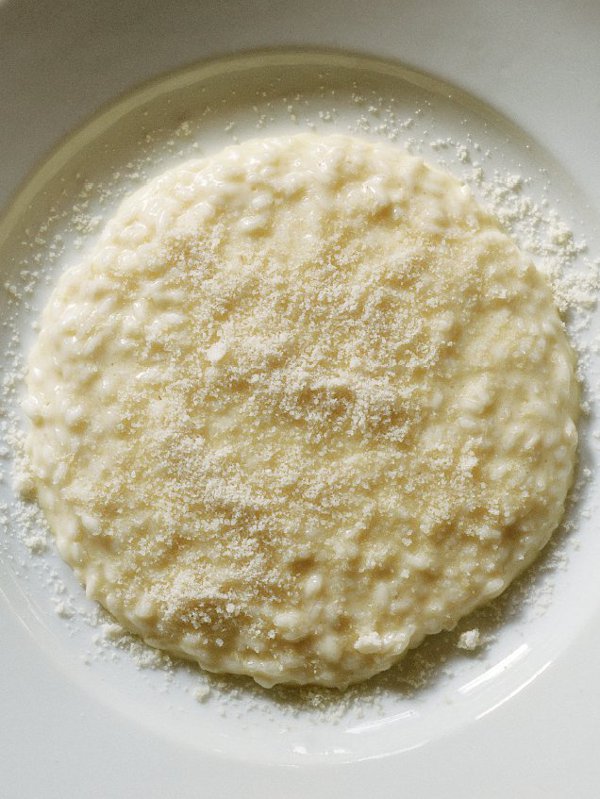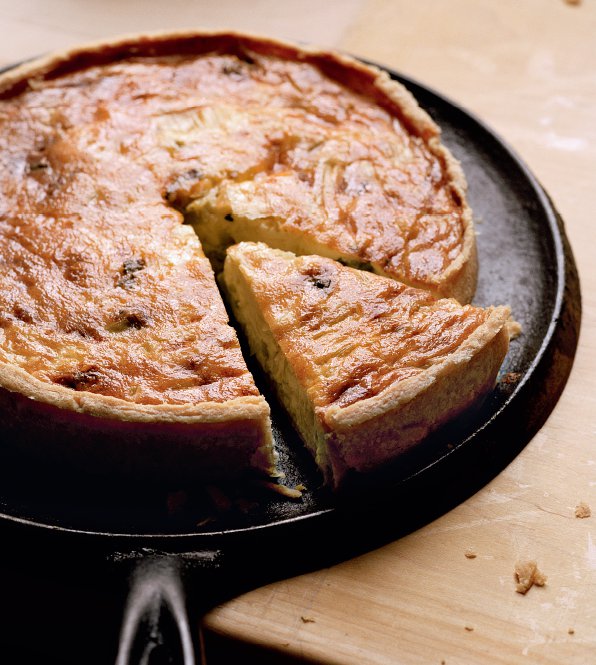Good Cook (6 page)
Authors: Simon Hopkinson

serves 4
18 oz white part of leek, cut into thick rings, well washed and drained
12 oz water
4 tbsp butter
scant ½ tsp ready-ground white pepper
2 tsp Maldon (or other) sea salt
1 bay leaf
9–10½ oz tasty Lancashire cheese, coarsely grated
4 large, very fresh eggs
1 tbsp finely snipped chives
This recipe produces one of the simplest and nicest dishes. Perfect for a Sunday supper, eaten with thick slices of buttered white bread from a soft and floury bloomer. The eggs should be as fresh as can be, as only then will you achieve a neat and tidy poached egg. I like a splash of vinegar, because I grew up with that flavor, but it also helps to coagulate the white. Generally, I simply crack the eggs into the simmering water, allow them to settle, cover the pan and switch off the heat. Left for 3–4 minutes, they will be runny-yolked and with a just-set white.
Note: use only the white part of the leeks, and try to find large fat ones, for the best flavor, robust and hearty. Also, forgive me, but ready-ground white pepper has the correct taste, here—as it does with cockles in vinegar by the seaside. If you find such a condiment offensive, then please feel free to cook something else.
Put the leeks into a pan with the water, butter, pepper, salt and bay leaf. Bring to the boil, turn down to a low simmer, cover, and cook for about 30 minutes, or until the leeks are good and soft. Heat an overhead grill.
Once the leeks are cooked, stir them well and then divide between 4 preheated shallow, ovenproof dishes. Have a pan of simmering water (add a splash of vinegar, if you like it) ready to poach the eggs. Now sprinkle each dish of leeks with the cheese and place under the broiler, only to melt the cheese, not to brown it. Poach the eggs and place one into each dish. Sprinkle over the chives and serve without delay.
serves 2
1 small onion, very finely chopped
5 tbsp best unsalted butter
1¾–2 cups pale, lightly flavored chicken stock
1 small glass of dry vermouth (approx 4¼ oz)
7 oz carnaroli (or other risotto) rice
3–4 tbsp freshly grated Parmesan
a little salt and freshly ground black pepper
The simplest and most daringly naked of all risotto. The dish reminds one that, as always, good risotto-making is all about the rice and how carefully it is cooked. I have, in fact, occasionally made this using only water, where the quality of butter and cheese is even more paramount.
If you find that the rice is cooked before you finish off the stock, don’t worry. Conversely, if you think you need more liquid, simply add extra hot water. A good risotto should be of lava-like consistency, lazily oozing, and should take a good few seconds before it finally settles on the plate.
Using a deep-sided, heavy-bottomed pan, quietly fry the onion in 3 tbsp of the butter until well softened but not colored. Meanwhile, heat the stock in another pan. Now add the vermouth to the onions, turn up the heat and reduce until almost evaporated. Pour in the rice and, stirring vigorously using a sturdy wooden spoon, allow the rice to become shiny with butter before adding a ladleful of hot stock. Continuing to stir with vigor; let the rice absorb the stock before adding another ladleful; you may not need all the stock.
When the risotto is looking a lovely, pale ivory color, is sloppily pourable and the rice is starting to become tender and
not
chalky in the middle (eat the odd grain as you go, to check), remove from the heat and quickly stir in 2 tablespoons of cheese and the remaining butter. Cover and leave to settle for 5 minutes. Now, check for seasoning and vigorously beat the rice together with a wooden spoon until slick and glossy; it should easily fall back on itself when lifted. Spoon on to hot plates and hand around extra Parmesan at table.


makes about 25–30 bicuits
7 tbsp cold unsalted butter, cut into chunks
1
1
/
3
cups all-purpose flour
pinch of salt and cayenne pepper
½ heaped tsp mustard powder
2 oz finely grated mature Cheddar
2 oz finely grated Parmesan, plus a little extra
1 egg, beaten
Those who have come across me before will know that this is a second outing for these delectable cheese biscuits. However, they are so very good that I felt the need to force them on you once again, here. My eternal thanks go to my friend Rachel Cooke, who first showed me how to make them. Ta ever so, Cooky.
Preheat the oven to 350°F.
Place the butter and flour in the bowl of a food processor, together with the salt, cayenne, mustard and cheeses. Process together, to begin with, and then, finally, pulse the mixture in short spurts as you notice the mixture coming together—as pastry, if you like. Once the texture is clearly “clumpy,” tip out on to a lightly floured surface and deftly, but thoroughly, knead it together until well blended and smooth. Wrap in plastic wrap and chill in the fridge for at least 30 minutes.
Lightly flour a work surface and gently roll out the pastry to about
1
/
10
in thick. Cut out the biscuits to the size and shape you wish for—anything between 1½ in and 2 in, depending on the occasion. Lay them out on a greased baking tray about ¾ in apart; it may take two lots of baking to use up the entire mixture. Carefully brush the surface of each biscuit with the egg and sprinkle over a little finely grated Parmesan. Bake in the oven for 10 minutes, or until a gorgeous golden color is achieved; the superb smell will also inform you that they are ready. Carefully lift off the tray using a palette knife and place on a rack to cool. Although the biscuits will keep well in a sealed container for a few days, I have never known this to happen.

serves 2
2–3 heads of chicory, separated into leaves and put to soak in iced water
1 large, ripe pear, peeled and thinly sliced
4 oz Roquefort, crumbled
a squeeze of lemon juice
2–3 tbsp walnut oil
freshly ground black pepper
Of all blue cheeses, Roquefort will always remain my favorite. I will take a small slice of Stilton—or even better, Stichelton—at Christmas, or maybe a thick wedge of sweetly savory Fourme d’Ambert when in a good French restaurant. And I am very fond of a fine and creamy Gorgonzola or Dolcelatte, from time to time. But Roquefort, the king of blue cheeses, takes the biscuit.
Anyway, here is a very fine, very simple salad: all at once fresh, crisp, salty, sweet and fragrantly oily—and just perfect when using Roquefort that is cool and crumbly. Use either the red-leafed or traditional white chicory, here.
Dry the chicory leaves (a spinner is best, here) and neatly arrange on a serving dish, inner curved sides uppermost. Evenly distribute the pear in and among the leaves, crumble over the cheese and squeeze over a touch of lemon juice. Trickle over the walnut oil and grind over the pepper. Serve forthwith.
serves 6, as a first course
pastry (see
page 170
)
2 tbsp butter
9 oz leeks, well trimmed, sliced, washed and drained
2 egg yolks
2 eggs
5 oz double or heavy cream
4 oz sour cream
small bunch of chives, finely chopped
a little salt and plenty of freshly ground black pepper
freshly grated nutmeg
9 oz Roquefort, cut into small chunks
Once again, the combination of cheese and allium knows no boundaries. The texture here should be wobbling and luscious, and with a crisp pastry shell holding everything together—but only just. Other firm blue cheeses may be used instead, but the deeply savory and complex Roquefort, once again, shines through.
For the pastry, please refer to the Quiche Lorraine (see
page 170
).
You may not need all of it, so freeze the remainder, wrapped in plastic wrap.
Preheat the oven to 350°F. Place a flat baking sheet in the oven, too, to help the cooking of the base of the pastry crust.
Roll out the pastry as thinly as possible and line a 8 in wide by 1½ in deep tart tin. Lightly prick the base of the pastry with a fork all over, and then bake blind. This is done by lining the uncooked pastry crust with a sheet of kitchen foil and filling with some dried beans, for instance. It is then cooked on the flat baking sheet for about 15–20 minutes, removed from the oven, the foil and beans transferred to a container for future use. Return to the oven for a further 10 minutes or so, until it is pale golden, crisp and well cooked through, particularly the base.
Now, melt the butter in a pan and add the leeks. Allow to quietly stew until soft, and with very little bubbling buttery juices left in the pan. Tip out on to a plate and leave until cool. Loosely whisk together the egg yolks and whole eggs in a bowl. Stir in both the creams, the chives, a little salt, pepper and nutmeg and set aside.
Strew the leeks over the base of the tart and then cover these with the nuggets of Roquefort, evenly distributed. Pour over two-thirds of the egg/cream mixture and slide the tart into the oven. Only now add the remaining mixture as high as you dare, therefore avoiding spillage caused by shaky transportation. Bake for about 40–50 minutes, or until lightly puffed and set, with a gorgeous golden surface. Serve warm, not hot.


wine
